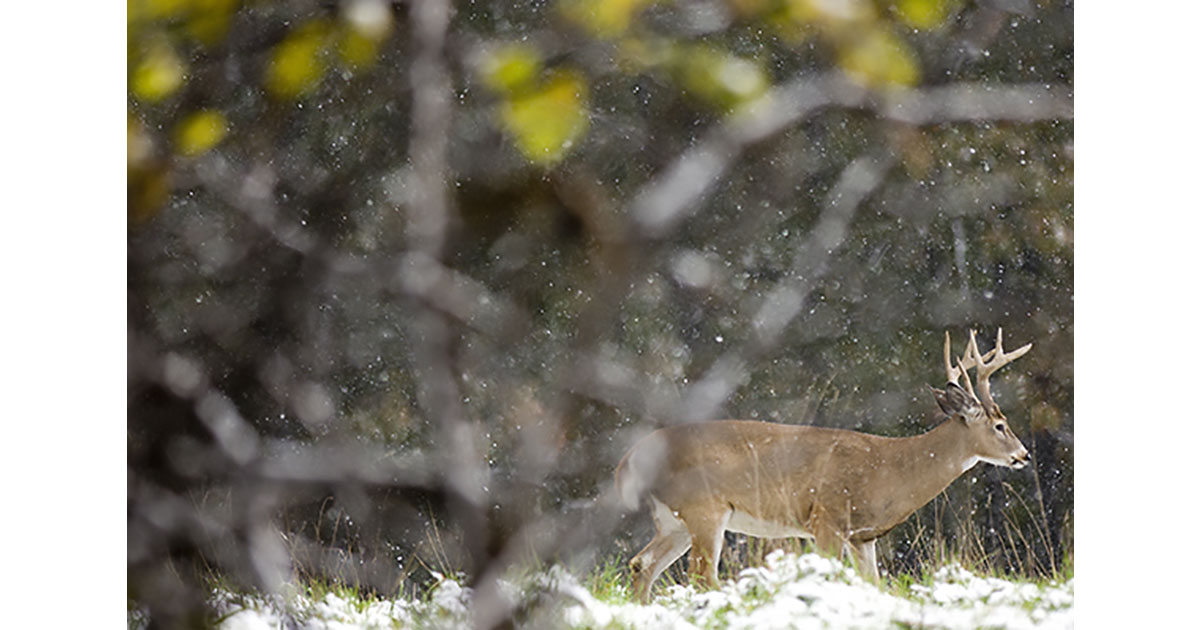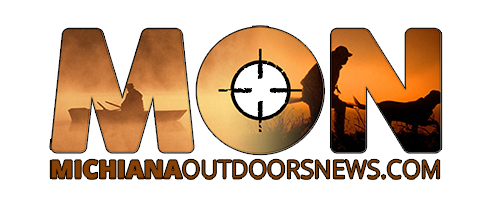- Details
MDNR Report
 Deer in the Snow
Deer in the Snow
With the archery deer hunting season already underway and the firearm deer season opener just around the corner, here are some regional hunting forecast notes from Michigan Department of Natural Resources Wildlife Division staffers.
Southern Lower Peninsula
Deer numbers remain high throughout much of the region. Routinely mild winters and abundant summer foods mean deer are rarely negatively affected by winter mortality. Fawn survivorship remains high, with many twins, and even triplets, being reported.
Precipitation across the region this spring and summer was good, but timing varied depending on the specific area. Farmers in some places were able to plant crops early, while others had to wait for the ground to dry out and plant some crops late. Timing of harvest this fall will vary accordingly, but dry conditions in late summer/early fall may have corn harvest trending earlier than last year.
Rainfall totals in late summer have also been variable, with many areas seeing drier conditions. Cases of epizootic hemorrhagic disease have been reported in many counties, especially in southwest Michigan.
Reported cases started earlier than has been seen in most years. These earlier cases and continuing hot, dry conditions could allow the virus to be on the landscape for an extended period, as a good frost is needed to kill off the midge flies that transmit the virus.
For areas where the virus has been circulating since late July or early August, impacts on the local deer herd could be extensive. Areas where the virus did not start circulating until mid- to late September will likely see less effects. The DNR will be closely monitoring these conditions and encourages people to report suspected cases of EHD at Michigan.gov/EyesInTheField.
Chronic wasting disease is still present in many counties in southern Michigan, and continued monitoring is still a priority for the DNR. However, while the DNR continues to get baseline data for CWD presence across the state, the department is not actively seeking samples from counties in the southern Lower Peninsula this year.
This part of the state has already had extensive sample collection, and resources are instead being used to collect data in other parts of the state. If you hunt in a county with known CWD cases, there are still options for testing if you choose to do so – see Michigan.gov/CWD for more information.
There are a handful of regulation changes in effect this fall for the southern Lower Peninsula.
The early and late antlerless seasons are now open on private and public lands. In the past, these seasons were only available on private lands.
The extended late archery season, formerly known as the “urban archery season,” has been expanded to include Huron, Kent, Lapeer, Sanilac, St. Clair (except deer management unit 174), Tuscola and Washtenaw counties, in addition to Macomb, Oakland and Wayne counties. This season runs Jan. 1-31.
A new extended late antlerless season will run from Jan. 2 through the second Sunday in January (Jan. 12, 2025) in select counties in the southern Lower Peninsula. For details regarding this new season, visit Michigan.gov/Deer.
Hunters in most of the southern Lower Peninsula should consider harvesting an additional antlerless deer beyond what they would normally harvest. While some properties may require the harvest of dozens of antlerless deer annually to keep population numbers in check, more hunters harvesting just one more antlerless deer than normal will have a positive effect on balancing deer numbers and reducing the negative impacts of deer overabundance.
In areas where EHD has been present for several weeks, additional antlerless harvest may not be necessary. Where EHD hasn’t been on the landscape as long, antlerless harvest is likely going to still be required. While prolonged EHD presence can produce substantial impacts to a local deer herd, its distribution on the landscape can be extremely variable.
Some locations a short distance from severely impacted areas might not experience any effects of EHD. Parts of EHD-affected counties are likely to continue to need increased antlerless harvest efforts.
Understanding your local conditions and deer herd should drive your harvest decisions this fall.
Upper Peninsula
Most of the Upper Peninsula saw an extremely mild 2023-2024 winter, which was a welcome change from the previous two winters. Low snowfall and lack of extreme cold likely resulted in fewer deer affected by winter starvation and predation.
The result was deer coming out of the winter in better condition and with better fawn production, with many sets of twins being observed this spring. While conditions are going to vary locally, soft and hard mast production, such as apples and beech nuts, looks good this year.
Despite no additional cases of chronic wasting disease being detected in Dickinson County since 2018, the DNR is still collecting baseline surveillance data for CWD in many counties across the U.P.
The DNR encourages hunters to consider submitting a sample for CWD testing from deer harvested in Baraga, Chippewa, Dickinson, Houghton, Keweenaw, Luce, Mackinac, Ontonagon and Schoolcraft counties.
A few regulation changes for the U.P. should be noted before heading into the woods this fall.
After being removed in 2018, a three-point antler-point restriction when hunting with a single deer license was reinstated for deer management unit 122.
Antlerless hunting during late archery season with the single deer or deer combo license is prohibited after Dec. 10 in mid-snowfall zone deer management units 017, 021, 027, 036, 117, 149, 152, 249, 252, 349 and 249.
Antlerless access permits for DMU 351 were reduced from 1,000 to 0, making antlerless hunting with an antlerless license not available in those DMUs. Antlerless harvest is still an option with a single deer license or deer combo license during the archery season through Dec. 10 (see previous paragraph).
Antlerless access permits for DMU 352 were reduced from 1,000 to 500.
For more on deer hunting regulations visit Michigan.gov/Deer.
Northern Lower Peninsula
An abundant mast crop last fall had deer heading into the winter in good shape. With an extremely mild winter, deer did not need to group up as much as they have during harder winters. This also made food readily available throughout the winter and resulted in deer coming through the spring healthy and with what appears to be good fawn survival. Most does have been observed with fawns, and many with twins.
Deer numbers can vary greatly across the northern Lower Peninsula, with some areas seeing high numbers while other areas are experiencing low numbers.
If you are in an area where deer are plentiful and you see evidence of browse lines (boundaries between normal vegetation growth and areas where the vegetation has been eaten by deer) or lack of natural forage where you hunt, you may want to consider harvesting an antlerless deer or two to help manage the deer herd.
If you hunt an area where deer numbers remain lower or are more balanced with the available habitat, it may be appropriate to continue to keep antlerless harvest similar to past practices.
Along with ongoing testing for bovine tuberculosis, the DNR continues to gather baseline data for the presence of chronic wasting disease across the state. This is being done to gain a better understanding of where the disease may occur in areas where adequate testing has not been done yet.
- Details
IDNR Report
 Hunt for HungerDonate your harvested deer to feed hungry Hoosiers. One donated deer can provide 200 meals for an Indiana family. Follow these simple steps:
Hunt for HungerDonate your harvested deer to feed hungry Hoosiers. One donated deer can provide 200 meals for an Indiana family. Follow these simple steps:
- Enjoy a deer hunting experience.
- Harvest a deer.
- Drop off the field-dressed deer at a local participating processor.
- Processing fees are paid for by Hunt for Hunger (at no cost to you).
- The processor creates healthy venison burgers to distribute to food banks.
For a list of Indiana Feed Hungry processors, click here.
- Details
IDNR Report
Indiana Conservation Officers are investigating a fatal fall from a tree stand that occurred Saturday in Starke County.
At approximately 3 p.m., officers and emergency personnel responded to the 3500 block of S. 700 E. in Knox for a report of a fatal tree stand fall.
Once on scene, officers discovered Larry Sedwick, 53, of Cedar Lake, was deer hunting from an elevated tree stand when he fell from the stand. Sedwick was not wearing a full-body safety harness and was pronounced dead on the scene.
The incident is still under investigation.
Conservation Officers remind all hunters to wear a full-body safety harness when hunting from an elevated hunting platform.
Assisting agencies include the Starke County Sheriff’s Office, Starke County Coroner’s Office, Starke County EMS, and Knox Police Department.
- Details
MDNR Report
Throughout Michigan, hunters are preparing stands, blinds and camps for the upcoming firearm deer season, which begins Friday, Nov. 15. Although there's understandable excitement ahead of the opener, the Michigan Department of Natural Resources reminds everyone to respect the state's five-day quiet period, Nov. 10-14.
During these five days, unless hunting for small game, waterfowl or fur harvesting, it is unlawful to transport or possess a rifle or shotgun with buckshot, slug load, ball load or cut shell in an area frequented by deer. Unloaded firearms securely encased or carried in the trunk of a vehicle may be transported to or from a hunting camp.
“Hunters know that they are on the cusp of another Michigan firearm deer season once we enter into the five-day quiet period,” said Capt. Pete Wright, DNR Law Enforcement Division. “Those critical days create a window of time, just before the opener, when hunters can catch their breath and the woods have a chance to calm.
"This period is like pushing a reset button, allowing deer to settle back into their day-to-day patterns, which in turn increases the chances of a successful hunt.”
Small game or waterfowl hunters and fur harvesters can still carry the appropriate firearm for the season. Small game and waterfowl hunters may carry shotguns with shotshells for hunting small game, but cannot possess buckshot, slugs, ball loads or cut shells during this time. Fur harvesters may carry rimfire firearms (.22-caliber or smaller) while actively hunting or checking traplines during the open furbearing animal season.
Refer to the 2024 Deer Hunting Regulations Summary for more information.
Contact the Report All Poaching hotline at 800-292-7800 to report trespassing, shooting or other related natural resource violations.
- Details
IDNR Report Applications open on Monday, Oct. 7 for hunters to participate in Indiana State Park deer management draw hunts. These hunts follow science-based wildlife management to maintain healthy deer populations in the regions where the hunts are hosted. Participating properties include the following state parks: Brown County, Chain O’Lakes, Charlestown, Clifty Falls (archery only), Fort Harrison (archery only), Harmonie, Lincoln, McCormick’s Creek, O’Bannon Woods, Ouabache, Pokagon, Potato Creek, Prophetstown, Shades, Shakamak, Spring Mill, Summit Lake, Tippecanoe River (archery only), Turkey Run, Versailles, and Whitewater Memorial, as well as Cave River Valley Natural Area, Raccoon State Recreation Area (SRA), and Trine SRA. “Across Indiana’s public lands, we work throughout the year to assess and properly manage our wildlife populations, designed around promoting healthy ecosystems,” said Anthony Sipes, natural resources manager for Indiana State Parks. “We invite hunters to apply to help us with this vital mission at our state parks.” Hunters can apply starting at 12:01 a.m. ET at on.IN.gov/reservedhunt, which is the only way to apply and is the one-stop shop for all pertinent information. Hunters will be selected through a random computerized drawing. A link to view drawing results will be posted at the website listed above after the results are complete. Firearm hunts include any firearm legal to take deer on public land in Indiana. Archery hunts include any archery equipment legal to take deer in Indiana, including crossbows. Early hunts are Nov. 18-19, and late hunts are Dec. 2-3. Applicants must possess any valid license to take a deer in Indiana at the time of the application. By the date of the first hunt, applicants must be Indiana residents or possess a valid lifetime license to take deer in Indiana and be 18 years of age. Once an application has been submitted, information cannot be changed. Applications must be completed by the application deadline, Oct. 27.




